Pigmy Pouter Pigeon: Exceptional Avian Beauty
In the pigeon world, pigmy pouter pigeon is a well-known name. This peculiar-looking bird might not be the most beautiful, but it attracts pigeon lovers with its exceptional features and traits.
You can identify these pigeons from the large globe formed around the neck and chest area. They are descendants of the rock pigeons, so the physical traits are a result of cross-breeding. These birds are mostly kept as indoor pets.
Plus, they are also regularly displayed in pigeon exhibitions and shows.
Let’s know more about the origin, physical and behavioral traits, care, breeding, and maintenance of these amazing birds.
Pigmy Pouter Pigeon Profile
| Name | Pigmy Pouter Pigeon |
|---|---|
| Scientific Name | Columba Livia Domestica |
| Common Names | Pigmy Pouter |
| Origin | England |
| Size | Around 7-12 inches |
| Weight | 200 to 300 gram |
| Lifespan | 7 to 10 years |
| Physical Features | Narrow head, erect slim body with a puffed-out globe in the neck and chest area, short and narrow tail |
| Temperament | Calm and gentle |
| Behavior | Social and friendly |
| Special Features | Puffed out globular neck |
| Breeding and Maintenance | Needs special requirements like diet, natural light, proper environment, and care for breeding and maintenance |
| Common or Popular Varieties | Varieties with different colored bar markings (ashy, brown, red, blue, yellow, white, etc) |
Interested in similar topics on pigeon breed:
Overview
Pigmy pouter pigeons, also known as the pouter or Cropper pigeon are a unique variety of domesticated pigeons. The name pouter or cropper comes from the inflated crop on its neck.
Because of their calm demeanor, pouter pigeons are not fit to live like feral pigeons. They are not considered as beautiful as other fancy pigeons.
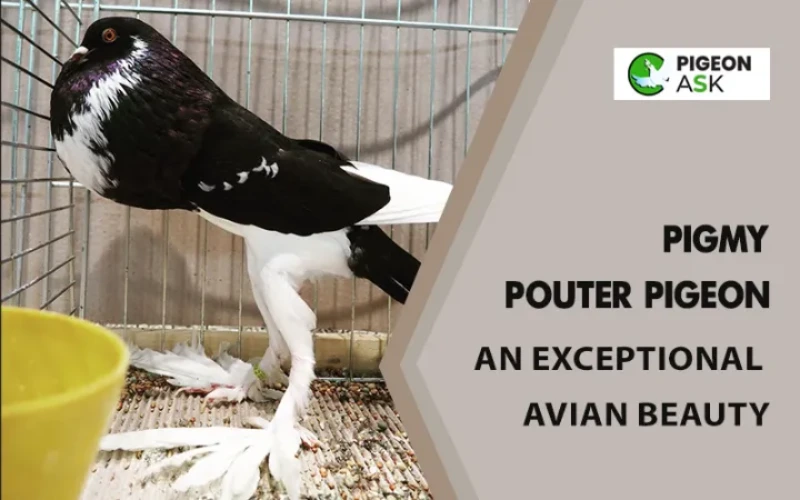
Still, some people may like to keep them as pets for their unusual appearance. But the main purpose of breeding these pigeons is for shows and exhibitions.
Due to their delicate nature and lack of endurance and speed, they also have no use in conventional pigeon races and such sports.
History And Origins of Pigmy Pouter Pigeons
The pigmy pouter pigeon is a miniature version of the famous English pouter pigeon. Since there is no exact information about when they were first discovered, it’s not possible to trace their actual origin.
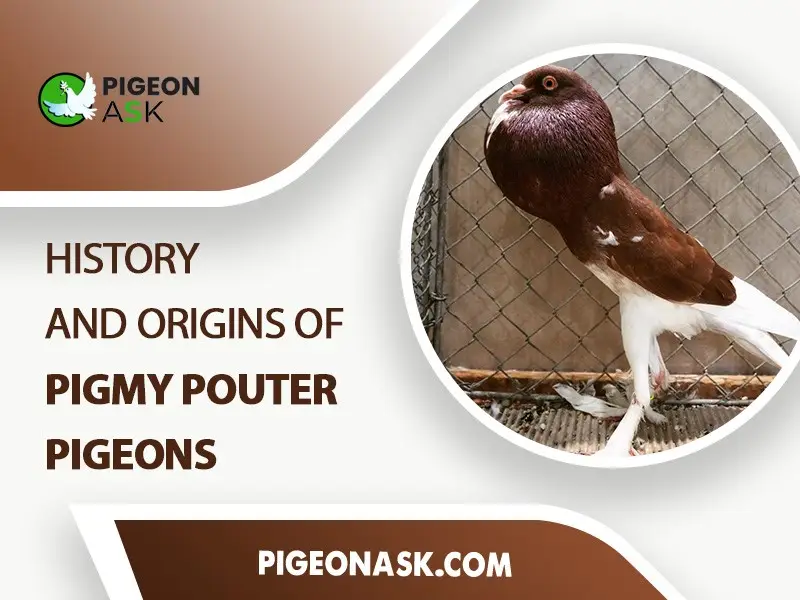
But it’s believed that they were first found in the 18th century in England. Famous British pigeon breeder Sir John Sebright is considered to be the first one to breed this unusual variety of pigeon.
How They Were Breed and Developed
Pigmy pouters were developed by selective cross-breeding between the English pouter and other domestic pigeons like the horseman.
Selective breeding is responsible for the inflatable crop in these pigeons. It’s believed that the breeders tried to create a pronounced crop of the English pouter while reducing the body size.
This is another reason why Pigmy pouters are considered a miniature version of the pouter pigeon.
Different colorations like red, yellow, blue, and ash bar markings in these pigeons were also developed through careful selective breeding.
Physical Characteristics And Features
Pigmy pouter pigeons have an unusual and different appearance than most other pigeon breeds. Let’s look at a brief description of their physical characteristics and features.
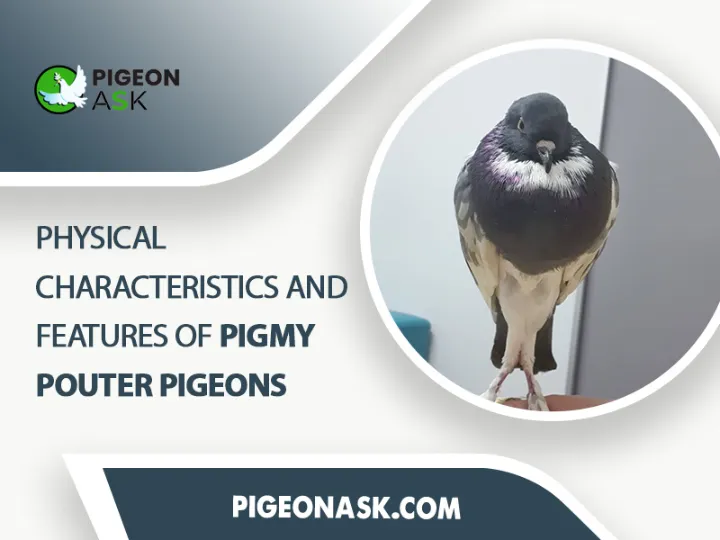
At a glance –
| Characteristic | Description |
|---|---|
| Head | Small, dove-shaped, smooth on top |
| Globe | Large, globular in form, forward in position and rising without over inflation |
| Size | The ideal Pigmy Pouter should not be substantially more than 12″ in height measured perpendicularly from floor to top of head |
| Color | Traditionally Pigmy Pouters are: pied bar pattern, pied solid color, or white |
| Markings | In pied Pigmy Pouters, the designated color covers the entire bird |
| Legs | Slim and slender, with limbs close together |
| Eyes | Very alert, bull or colored |
| Wattle | Small and fine |
| Back | Long and narrow |
| Neck | Proportionately long |
| Wings | Narrow, tucked close to the body, and taper into thin webbed flights |
| Tail | Short and very narrow, carried off the ground |
Appearance
Pigmy pouter pigeons are considered more elegant than conventionally beautiful.
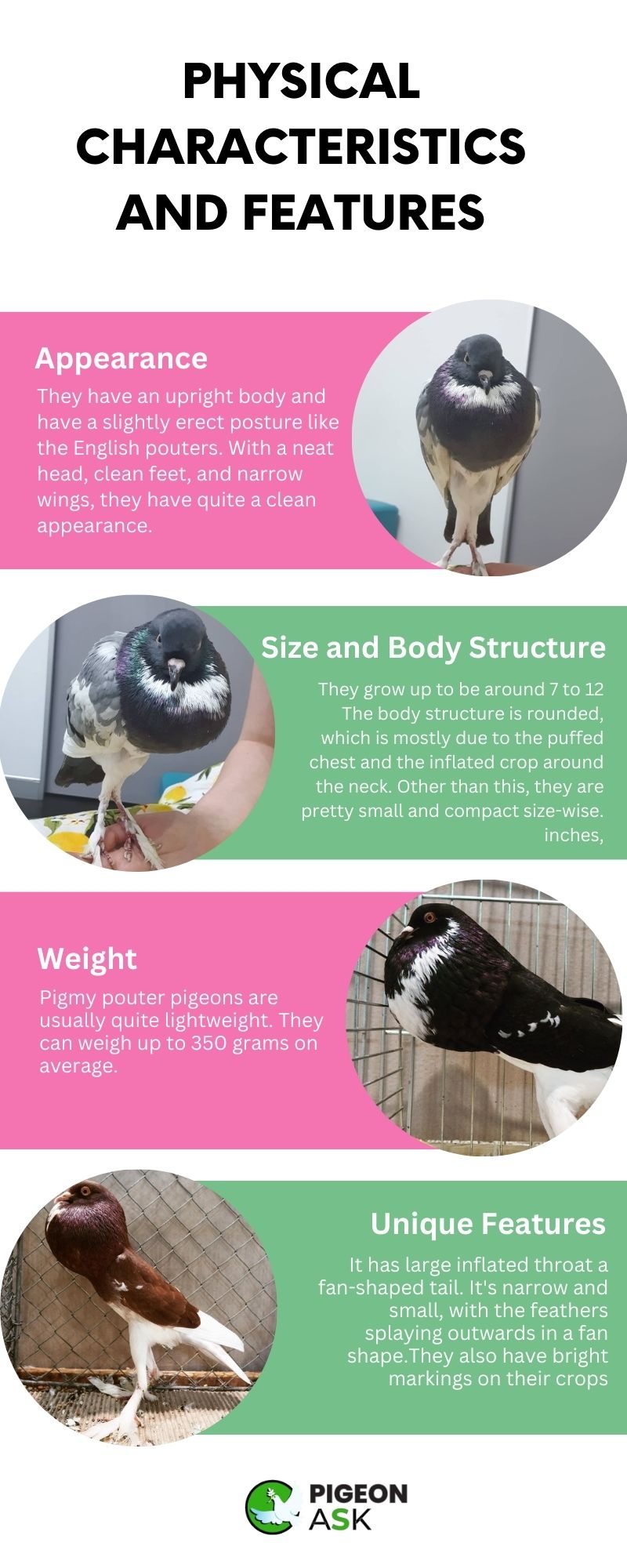
They have an upright body and have a slightly erect posture like the English pouters. With a neat head, clean feet, and narrow wings, they have quite a clean appearance.
The most intriguing part of their appearance is the large globe. It starts almost from the bottom of their chest and goes up to their neck or throat. The globe, along with the puffed-out chest, makes them stand out from other pigeon varieties.
Pigmy pouters tend to walk with their limbs close together, which makes them look graceful.
Size and Body Structure
Pigmy pouters have a well-proportioned body. They grow up to be around 7 to 12 inches, which is slightly smaller than the English pouters.
The body structure is rounded, which is mostly due to the puffed chest and the inflated crop around the neck. Other than this, they are pretty small and compact size-wise.
Weight
Pigmy pouter pigeons are usually quite lightweight. They can weigh up to 350 grams on average.
Unique Features, Like Their Fan-Shaped Tail
We have to mention the characteristic pout or crop as one of the main features of these birds.
Besides the large inflated throat, pigmy pouters have another unique feature: a fan-shaped tail. It’s narrow and small, with the feathers splaying outwards in a fan shape.
They also have bright markings on their crops.
Some Common Variation in Colors and Markings Across Different Species
Most people tend to focus on the peculiar physical traits of pouter pigeons rather than their coloration. However, they come in quite a variety of colors and markings across their body.
Firstly, they have bright markings on their globe. It can be white, bright ashy, or yellowish. Plus, they may have ashy, yellow, red, blue, dun, khaki, and brown bar markings on their body.
Distribution And Habitat
Pigmys are domesticated pigeon breeds. But they have distinct habitual preferences. Let’s know more in detail.
Geographic Distribution
As we have already said, pigmy pouter pigeons first originated in England. They were bred and distributed there for a long time until their popularity rose.
Later on, they spread across the globe due to their demand for pigeon lovers and breeders. Now you can find these amazing birds in other countries as well.
Habitat Preferences
Due to their domesticated nature, pigmy pouters are kept and raised indoors. They are docile and not fit to live in the wild. In fact, they thrive in captivity instead of being out in nature.
You can keep them in large cages or aviaries with a good environment, proper food, and safety.
Urban and Rural Habitats
Just like any other domesticated bird, many people like to keep Pigmys in their backyards. Especially in the urban and rural areas, it’s quite common to raise these pigeons in a semi-closed confinement or birdhouse.
Migration and Seasonal Movements
Due to the lifelong domestication process, pigmy pouters have little to no homing instinct. They are usually kept in captivity, so there’s no need to migrate as well.
Even when kept in a semi-closed area, these pigeons show no intention to leave their home.
Threats and Conservation Status
Pigmy pouters are completely tamed in nature, so they are easy prey to dogs, cats, other animals, and predatory birds. This is why it’s important to make sure the aviary is safe and secured from predator attacks.
Alongside, they are also prone to common bird diseases.
As for the conservation status, pigmy pouters are definitely less in number than other fancier pigeons. They are not exactly attractive, so breeders are not very interested in breeding them in large numbers.
However, many breeders are actively trying to populate them in order to ensure a safe conservation scenario.
Behavior And Traits of Pigmy Pouter Pigeons
Pigmy pouters have fun behavioral traits and make amazing pets.

Common Personality Traits
Pigmy pouters are very calm-natured and non-aggressive. They rarely get into fights with other birds and usually mind their own business. Not to mention, they are very social as well, so they make excellent cage mates for other gentle birds.
Besides, Pigmys require constant care so they share friendly connections with their caregivers. You may find them playing and interacting with their owner in playful manners.
Differences Between Wild and Domesticated Pigeons
Pigmys are fully domesticated, so they have characteristics similar to domestic birds. Even if you release them in the wild they may not live very long due to starvation, predation, diseases, etc.
They also don’t have the expertise to locate and hunt food in the wild so dying of hunger and predation is very probable.
However, if there is an abundance of food and water in a safe environment, they may be able to live like wild birds as well.
Diet
Pigmys are not picky eaters and will eat about anything you give them from seeds, grains, processed bird food, commercial pellets, etc.
You can also add greens and leaves to their diets. Lettuce, spinach, and kale broccoli are good options for that.
Besides, they like occasional treats like small insects and worms.
Temperament
Throwing tantrums or being aggressive is not in the nature of these well-behaved birds. They are loyal and will stay with their owner all the time if taken care of.
You can even perch them on your finger or shoulder without any vicious bite attack.
Similarly, they don’t show hostility towards other birds either. In fact, in a large-natured group, they blend in quite easily.
Flight
Pigmy pouters can fly quite well but they are not known for their flying abilities. In the case of flying high and long, they definitely fall short. Instead, they are more suited to leisurely perch on the loft.
Nesting, Breeding and Courtship
Pigmy pouters breed by courting, mating, laying eggs, and incubating them. They are monogamous and take one mate for a very long time, sometimes for the entirety of their life.
Usually, cooing, flapping, and fanning the tail are common courtship behaviors.
They build their nesting spots by laying leaves, straws, hays, and other things they can find.
For indoor pet Pigmys, you can also build nesting areas with dry clothes, straws, etc. Once the females have laid eggs in the nest, they take turns protecting the eggs until they have hatched.
When the babies have developed and learned to fend for themselves, the parents take care of them by collecting food and feeding them.
Homing Instinct
Pigmy pouters don’t have a strong homing instinct. They can still come back home due to their natural instinct as pigeons. But if taken far from home, they can easily get lost on the way.
Breeding And Maintenance
Breeding and maintaining pigmy pigeons are not that difficult, but you still need to know some basics to successfully breed them in captivity. Let’s take an in-depth look at their breeding conditions.
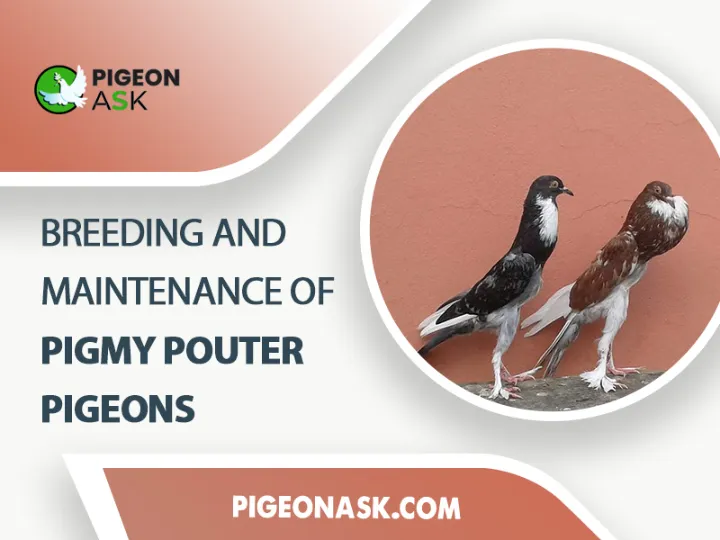
Information About Raising and Breeding
Pigmy pouter pigeons breed through summer and spring. To breed them in captivity, choosing a healthy and compatible pair is the first criterion.
Then, you can start creating a proper breeding environment with essentials like food, water, heat, safety, nesting spots, etc.
After the pair has laid eggs, it takes around 17 to 19 days to hatch them.
During this time, they need proper care to raise healthy offspring.
Some Tips and Considerations for Successful Breeding
For first-time breeders, here are some useful tips for successful breeding.
- Choose healthy pair
- Provide enough food and clean water
- Try to keep the space clean and dry by cleaning regularly
- In colder regions, arrange artificial heating to maintain a warm temperature( 98 to 100 F)
- There should be enough light and ventilation inside the house
- Monitor the birds closely during breeding for any usual behavior but don’t disturb them
- Maintain a quiet and peaceful environment
Feeding and Housing Requirements
Feeding and housing are extremely important for breeding pigmy pigeons. They require a safe and quiet environment to motivate them to start breeding.
A clean and warm space safe from wild animals, rain, and other adverse conditions is a must for this. The cage or house should be properly ventilated so there are no bacteria growing.
A wide aviator with indoor and outdoor space is ideal for this scenario. You’ll also need to build a nesting spot for them to lay eggs.
There should be a clean water source available for drinking inside the cage. As for the feeding, try to provide nutritious mixed grain along with greens and vegetables.
Protein intake is important in such times so insects and worms are good sources for that.
Final Words
To put it briefly, pigmy pouter pigeons are a very interesting yet graceful breed.
With their unusual appearance and natural, elegant mannerisms, they can attract anyone. For shows and exhibitions, they make excellent displays to showcase to pigeon lovers.
Not to mention, they are great pets for even first-time owners due to their gentle and playful nature. We hope you can learn a lot about these amazing birds. That’s all from us.
